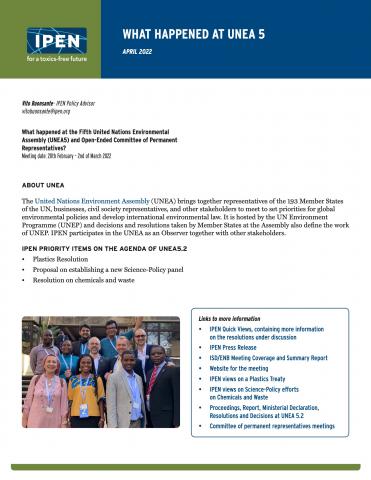What Happened at UNEA 5

A brief summary of the happenings and outcomes of the 5th Session of the United Nations Environmental Assembly (UNEA 5) meeting in Nairobi, Kenya, in Spring 2022, as well as notes about future events.
What happened at the Fifth United Nations Environmental Assembly (UNEA5) and Open-Ended Committee of Permanent Representatives?
Meeting date: 20th February – 2nd of March 2022
IPEN Priority Items on the Agenda of UNEA 5.2
- Plastics Resolution
- Proposal on establishing a new Science-Policy panel
- Resolution on chemicals and waste
OUTCOMES
Plastics Resolution
- UNEA adopted a resolution titled: “End plastic pollution: Towards an international legally binding instrument” that commits to start an Intergovernmental Negotiating Committee in 2022 to agree on a legally binding instrument to address plastic pollution in all environments and including microplastics.
- The resolution calls for addressing plastics throughout their lifecycle by addressing sustainable production and consumption. The resolution calls for addressing plastics design and applying a circular economy approach.
- The resolution underlines the importance of cooperation, coordination, and complementarity among relevant conventions to prevent plastic pollution and its related risks to human health and adverse effects on human well-being and the environment.
- Negotiations are set to start before the end of 2022 and a preparatory meeting should take place already in the first half of 2022.
Proposal on a Science-Policy panel
- UNEA agreed to start negotiation to establish a science-policy panel to contribute further to the sound management of chemicals and waste and to prevent pollution. The exact scope of the panel will be further specified during the negotiations.
- The panel should be an independent intergovernmental body with a program of work approved by its member governments to deliver policy-relevant scientific evidence without being policy prescriptive.
- The ad hoc open-ended working group will commence its work in 2022 with the ambition of completing its work by the end of 2024.
The Resolution on chemicals and waste:
- Invites the conference of the parties of the Basel Convention to consider further the issue of increasing levels of illegal transboundary movements of hazardous wastes and other waste, as reported by developing countries.
- Invites governments and all relevant stakeholders involved in the SAICM beyond 2020 process to put in place an ambitious improved enabling framework to address the sound management of chemicals and waste reflecting a lifecycle approach and the need to achieve sustainable consumption and production, and also addressing means of implementation at the fifth meeting of the International Conference on Chemical Management (ICCM 5).
- Extends the duration of the Special Programme for a period of five years, and includes the Strategic Approach and the sound management of chemicals and waste beyond 2020 in the Programme.
- Calls Member States and other stakeholders to take further action to reduce or eliminate the risks associated with the issues discussed in the Assessment Report on Issues of Concern.
- Invites international organizations, member states, and other stakeholders to address adverse impacts of pesticides and fertilizers and notes the joint FAO/WHO/UNEP initiative to eliminate the harm posed by highly hazardous pesticides.
- Requests the Executive Director, subject to the availability of resources in cooperation with WHO, to update the report on the state of the science of endocrine-disrupting chemicals published in 2012 by the sixth session of the UNEA.
- Requests the Executive Director, subject to the availability of resources and in cooperation with WHO, to present a full range of options to address asbestos contaminants in products and the environment for consideration by UNEA 6.
UNEA 6 is scheduled for 26 February to 01 March 2024, while the Open-ended Committee of Permanent Representatives will take place from 19 to 23 February 2024 to prepare the text of the resolutions that will be presented for approval at UNEA 6.
Document:
Document Type:
